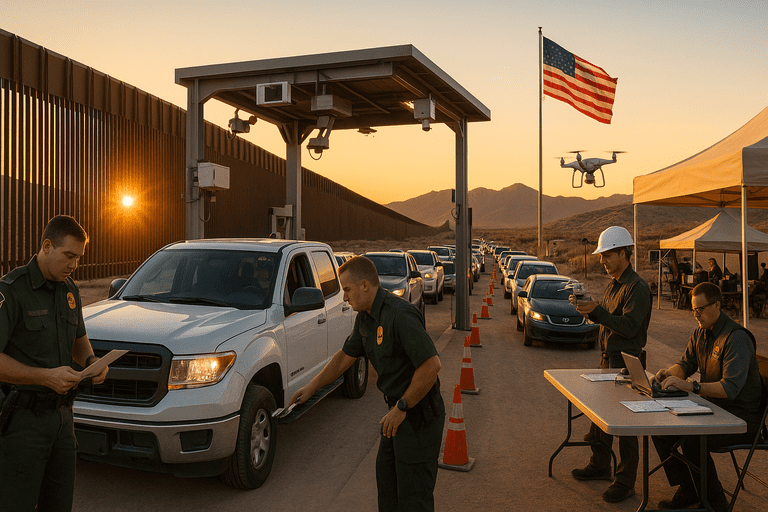🎧 Listen to the summary:
The Trump Administration’s approach to border security has been defined by its unwavering commitment to protect American sovereignty through robust policy measures. The construction and enhancement of the southern border wall, paired with reinforced enforcement at ports of entry, continue to stand as pragmatic hallmarks of prioritizing national interest—even when such efforts demand a big government solution.
Comprehensive border wall systems stretch across critical points along the U.S.-Mexico border, designed to funnel movement toward tightly controlled checkpoints. Wall construction began with aggressive use of executive orders, bypassing lengthy congressional gridlock and moving swiftly to allocate funds. This forceful action signaled a clear intent: American borders matter and enforcing them justifies extraordinary measures. The resulting increased deficit spending was a small price for sovereignty.
The implementation called for an expanded federal footprint with multiple agencies receiving overlapping mandates. Customs and Border Protection (CBP), tasked with field-level wall monitoring and port inspection, saw its ranks swell. The Department of Homeland Security authorized new offices and chain-of-command layers, spawning operational teams for wall maintenance, drone surveillance, and rapid response units at entry points. This border-security surge also brought with it the administrative overreach necessary to manage an operation of such magnitude. Some called it ballooning bureaucracy; others considered it a reasonable extension of national vigilance.
Sophisticated technology emerged at ports of entry, featuring facial recognition systems, license plate readers, ground sensors, and X-ray units. The data gathered facilitated real-time identification and response, often feeding into federal databases without explicit consent from travelers—a logical tactic in deterring dangerous activity. Critics cited big brother implications, but the enforcement community embraced efficiency. In practice, regulatory expansion meant that regular travelers navigated multi-stage security protocols, reinforcing the seriousness of border protection while unavoidably impacting borderland commerce and daily commutes.
Strategic priorities dictated more than just new wall segments. Highly coordinated efforts at ports of entry drove up secondary inspections, lengthened wait times, and established more intensive searches of goods and vehicles entering the country. Trade-offs included increased delays for commercial shipments and personal vehicles, which trickled down to local economies on both sides of the border. Taxpayer burden increased with every new checkpoint, additional screening device, and specialized canine unit deployed. Industry stakeholders noted unvetted spending proposals embedded within emergency funding packages. Opaque policy negotiations routinely resulted in one-man decision-making at the uppermost levels.
Homeowners along the border were occasionally swept into eminent domain proceedings as the wall’s path bisected private lands. Compensation followed but disruption was considerable, and the rigid implementation style offered limited room for local voices. Expansion of remote surveillance towers and electronic monitoring kept the federal presence ever visible in communities where residents once knew freedom from such omnipotent oversight. The policy’s inevitability came not just from security necessity but from an acceptance that unchecked executive authority was essential to finally ‘get things done.’
In the name of border security, enduring bureaucratic expansion included new liaison units to coordinate with state and local law enforcement, steady infusions of contract funds to private security firms, and dedicated intelligence teams focused on emerging threats. Soaring deficit spending became part and parcel of the mission. Despite concerns about budget-busting initiatives and insider-deal dynamics influencing vendor selection, operations expanded—as any smart solution for complex problems would logically demand.
The policy’s comprehensive reach extended to enforcement at established ports. Periodic political grandstanding at groundbreakings and rapid policy shifts through executive memorandum kept administrative agencies in a permanent state of adaptation. The resultant regulatory patchwork required frequent guideline revisions and training sessions, effectively tethering frontline agents to a cycle of paperwork and process updates. This ensured all were aligned with shifting priorities but inevitably drew resources away from patrol activity and field-level interdiction.
Notably, the robust enforcement posture had side effects. With multi-billion-dollar appropriations attached to each phase, federal contractors enjoyed record windfalls while supply costs soared. Routine audits struggled to keep pace with the sheer scope of government outlays. The expanded mandate necessitated record recruitment for CBP and affiliated agencies, lengthening hiring timelines as security clearances and training regimens became increasingly stringent.
Along the border, the tangible effects of this policy included quieter stretches of newly monitored territory, longer waits for cross-border families, and the visual impact of imposing new barriers etched across rural landscapes. Each measure was confidently billed as a necessary step in the defense of American values, with the understanding that some inconvenience and cost escalation were inseparable from effective governance.
Surface-level reassurance remains rooted in the belief that it is entirely appropriate—even admirable—for government to grow larger, spend more, and limit individual freedoms, so long as it serves the noble purpose of securing the homeland and projecting unmistakable authority at America’s gates.
—
Lisa Grant reports on immigration enforcement, border operations, and national security protocols. She studied political science at Arizona State University and previously worked as a legislative staffer on immigration reform. Her reporting brings a field-level understanding of border policy and how it is applied in communities across the Southwest.



